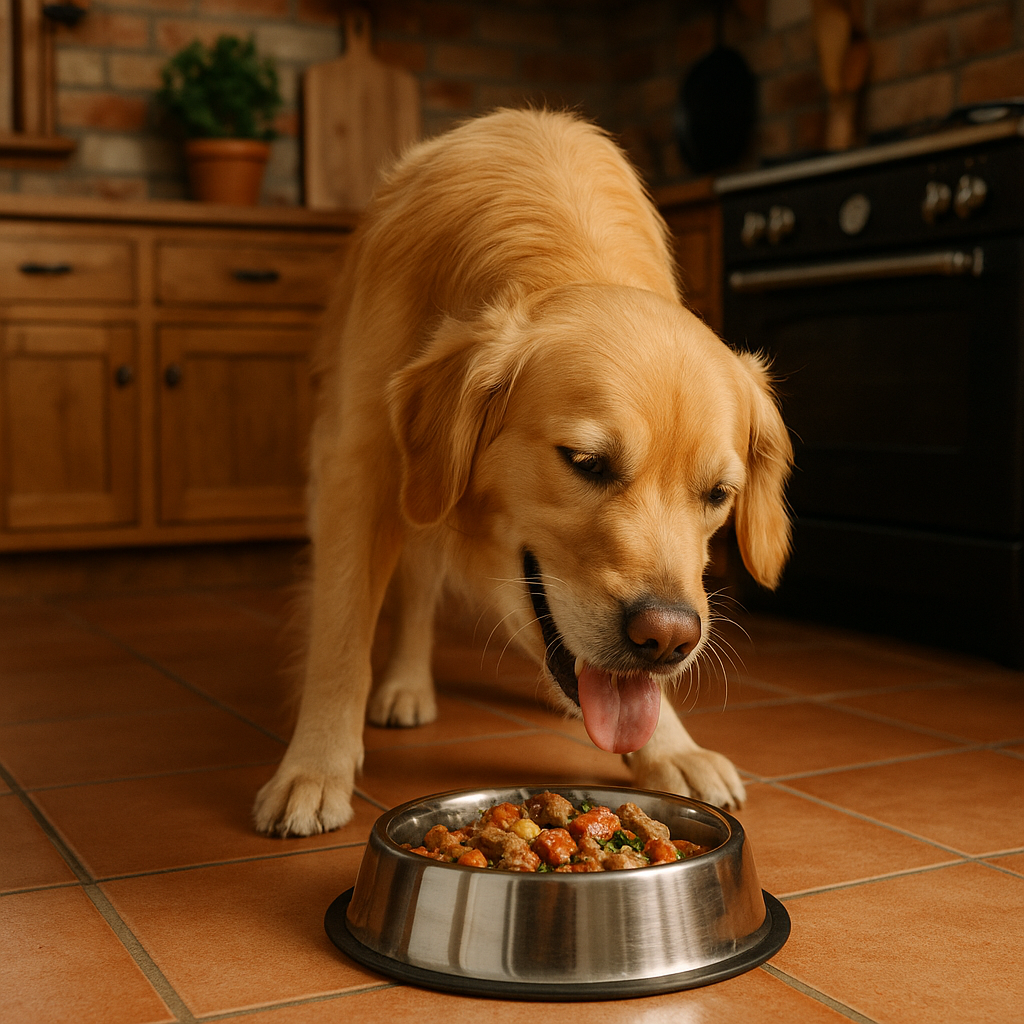Key Points
- Protein is essential for dogs, supporting muscle repair, immune function, and energy.
- Most adult dogs need 18-25% protein in their diet, but puppies and active dogs may need more.
- Quality matters—choose high-protein sources like fish, eggs, or insect protein for better nutrition.
- Too much protein can strain kidneys in dogs with health issues, so consult your vet.
- Studies show protein needs vary by age, size, and activity level—tailor your dog’s diet accordingly.
Introduction
Protein is often called the building block of life, and for dogs, it’s no different. It helps them build strong muscles, repair tissues, and stay energetic for those long walks in the park. But how much protein does your dog really need? With so much conflicting advice out there, it can be hard to know what’s best.
This vet-backed guide breaks down the science of protein for dogs, explains how much they need based on their age and lifestyle, and helps you choose the right food for your furry friend. Let’s get started!
Why Does My Dog Need Protein?
Protein is a vital nutrient for dogs, playing several key roles in their health:
- Muscle and Tissue Repair: Proteins are made up of amino acids, which are essential for building and repairing muscles, skin, and organs. For example, after a long run, your dog’s muscles rely on protein to recover.
- Immune Function: Proteins produce antibodies and enzymes that help fight off infections, keeping your dog’s immune system strong.
- Energy Source: While fats and carbs are primary energy sources, protein can also provide energy when needed, especially for active dogs.
- Healthy Coat and Skin: Amino acids like methionine and cysteine support a shiny coat and healthy skin, reducing issues like dryness or flaking.
Dogs can’t produce all the amino acids they need on their own, so they must get them from their diet. These are called “essential amino acids,” and there are 10 that dogs require, including arginine, lysine, and taurine. High-quality protein sources—like fish, eggs, dairy, or sustainable options such as insect protein—provide these amino acids in the right balance.
How Much Protein Does My Dog Need?
The amount of protein your dog needs depends on their age, size, activity level, and health. Here’s a breakdown based on vet recommendations and scientific studies:
- Puppies: Growing pups need more protein to support development—typically 22-32% of their diet. For example, a puppy might need 28g of protein per 1,000 kcal of food, compared to an adult’s 18g.
- Adult Dogs: For most adult dogs, 18-25% protein is sufficient for maintenance. This translates to about 18g of protein per 1,000 kcal, according to European pet food guidelines.
- Senior Dogs: Seniors often need 20-25% protein to maintain muscle mass as they age, but those with kidney issues may need less to avoid strain.
- Active Dogs: Dogs who run, hike, or work (like sheepdogs) may need 25-30% protein to fuel their energy and recovery.
- Dogs with Health Conditions: Dogs with kidney or liver disease may need restricted protein (e.g., 14-18%) to reduce organ stress. Always consult your vet for tailored advice.
A 2021 study on canine nutrition found that protein requirements can vary widely even within these categories, depending on a dog’s metabolism and breed. For instance, a 20-kg adult dog eating 1,000 kcal daily might need 18-25g of protein, while a more active dog of the same size might need closer to 30g.
Protein Needs by Dog Weight and Activity Level
Here’s a guide to protein needs based on weight and activity (consult your vet for specifics):
-
Small Dogs (4-10 kg):
- Low Activity: 8-12g protein daily
- High Activity: 12-15g protein daily
-
Medium Dogs (10-20 kg):
- Low Activity: 15-20g protein daily
- High Activity: 20-25g protein daily
-
Large Dogs (20-40 kg):
- Low Activity: 25-35g protein daily
- High Activity: 35-45g protein daily
These are rough estimates—your vet can help you fine-tune based on your dog’s specific needs.
What Are the Best Sources of Protein for Dogs?
Not all proteins are created equal. The quality of protein in your dog’s food matters just as much as the quantity. High-quality proteins are easily digestible and provide all the essential amino acids your dog needs. Here are some good options:
- Fish: Rich in omega-3s and amino acids, fish like salmon or mackerel also supports coat health.
- Eggs: A complete protein source, eggs are highly digestible and great for most dogs.
- Insect Protein: A sustainable choice, insect protein is packed with amino acids and is often hypoallergenic, making it ideal for dogs with sensitivities.
- Dairy: Small amounts of cheese or yoghurt can provide protein, but watch for lactose intolerance.
- Plant-Based Proteins: Options like peas or lentils can supplement protein but shouldn’t be the primary source, as they lack some essential amino acids dogs need.
When choosing dog food, look for labels where a high-quality protein is the first ingredient. Avoid foods with vague terms like “animal derivatives,” which may be lower quality. Also, check for “digestibility”—a measure of how much protein your dog can actually absorb. For example, insect protein has a digestibility of around 90%, similar to eggs, making it an excellent choice.
Can My Dog Have Too Much Protein?
While protein is essential, too much can cause issues in some dogs, especially those with health conditions:
- Kidney Strain: In dogs with kidney disease, excess protein can put stress on the kidneys, as they must filter out the byproducts (like urea). A vet might recommend a low-protein diet in these cases.
- Digestive Upset: Some dogs may experience diarrhoea or bloating if they’re suddenly given a very high-protein diet.
- Weight Gain: Protein is calorie-dense, so overfeeding can lead to obesity, especially in less active dogs.
However, for healthy dogs, excess protein is usually harmless—they’ll either use it for energy or excrete it. A 2022 study found that healthy adult dogs fed up to 35% protein showed no adverse effects, but balance is key. If you’re unsure, your vet can run tests to check your dog’s kidney function and recommend an appropriate protein level.
How Do I Know If My Dog Is Getting Enough Protein?
Signs of a protein deficiency are rare in dogs fed commercial diets, but they can happen if you’re feeding a homemade or unbalanced diet. Watch for these symptoms:
- Dull, dry coat or excessive shedding
- Slow growth in puppies
- Muscle loss or weakness
- Frequent infections (due to a weakened immune system)
On the other hand, if your dog is getting the right amount of protein, you’ll notice:
- A shiny, healthy coat
- Strong muscles and good energy levels
- Quick recovery after exercise
- Normal growth in puppies
If you suspect a deficiency, check your dog’s food label. Most commercial foods list protein as a percentage under “analytical constituents.” If it’s below 18% for an adult dog, it might be too low—especially if the protein source is low quality. Your vet can also do a blood test to check protein levels if needed.
How Can I Adjust My Dog’s Protein Intake?
If you think your dog needs more or less protein, here’s how to adjust their diet safely:
- Choose the Right Food: Look for foods with a protein percentage that matches your dog’s needs. For example, a working dog might thrive on a food with 28% protein, while a senior dog with kidney issues might need one with 16%.
- Supplement with Treats: High-protein treats like dried fish or insect-based snacks can boost intake for active dogs. Just keep treats to 10% of their daily calories.
- Mix Foods: If your dog’s current food is too low in protein, mix in a higher-protein option (e.g., wet food or a topper) over a week to avoid digestive upset.
- Monitor and Adjust: After changing their diet, watch for signs of improvement (e.g., better energy) or issues (e.g., loose stools). Adjust as needed with your vet’s guidance.
Tips for Adjusting Protein Intake
Here are some practical tips to ensure your dog’s protein intake is just right:
- For Puppies: Choose a puppy-specific food with at least 22% protein and high digestibility.
- For Active Dogs: Opt for foods labelled for “active” or “working” dogs, often with 25-30% protein.
- For Seniors: Look for senior formulas with moderate protein (20-25%) and joint-supporting nutrients.
- For Dogs with Health Issues: Work with your vet to find a prescription diet if your dog has kidney or liver problems.
Always transition to a new food gradually over 7-10 days to avoid tummy troubles.
Conclusion
Protein is a vital part of your dog’s diet, but getting the right amount is all about balance. Most dogs thrive on 18-25% protein, but puppies, active dogs, and seniors may need more or less depending on their needs.
By choosing high-quality protein sources—like fish, eggs, or insect protein—and tailoring their diet to their life stage and activity level, you can keep your dog healthy and happy. If you’re ever unsure, your vet can offer personalised advice to ensure your dog’s diet is spot-on. Here’s to many more joyful walks with your well-nourished pup!
FAQ: Common Questions About Protein for Dogs
-
How do I know if my dog’s food has enough protein?
- Check the label for a protein percentage of at least 18% for adults, and ensure the first ingredient is a high-quality protein source.
-
Can I feed my dog a high-protein diet if they’re not active?
- Not usually—less active dogs may gain weight on high-protein diets. Stick to 18-20% protein for sedentary dogs.
-
Is insect protein a good option for my dog?
- Yes, it’s a sustainable, high-quality protein that’s easy to digest and great for dogs with sensitivities.




